ECU MAZDA MODEL CX-5 2018 (in English) User Guide
[x] Cancel search | Manufacturer: MAZDA, Model Year: 2018, Model line: MODEL CX-5, Model: MAZDA MODEL CX-5 2018Pages: 628, PDF Size: 82.38 MB
Page 44 of 628
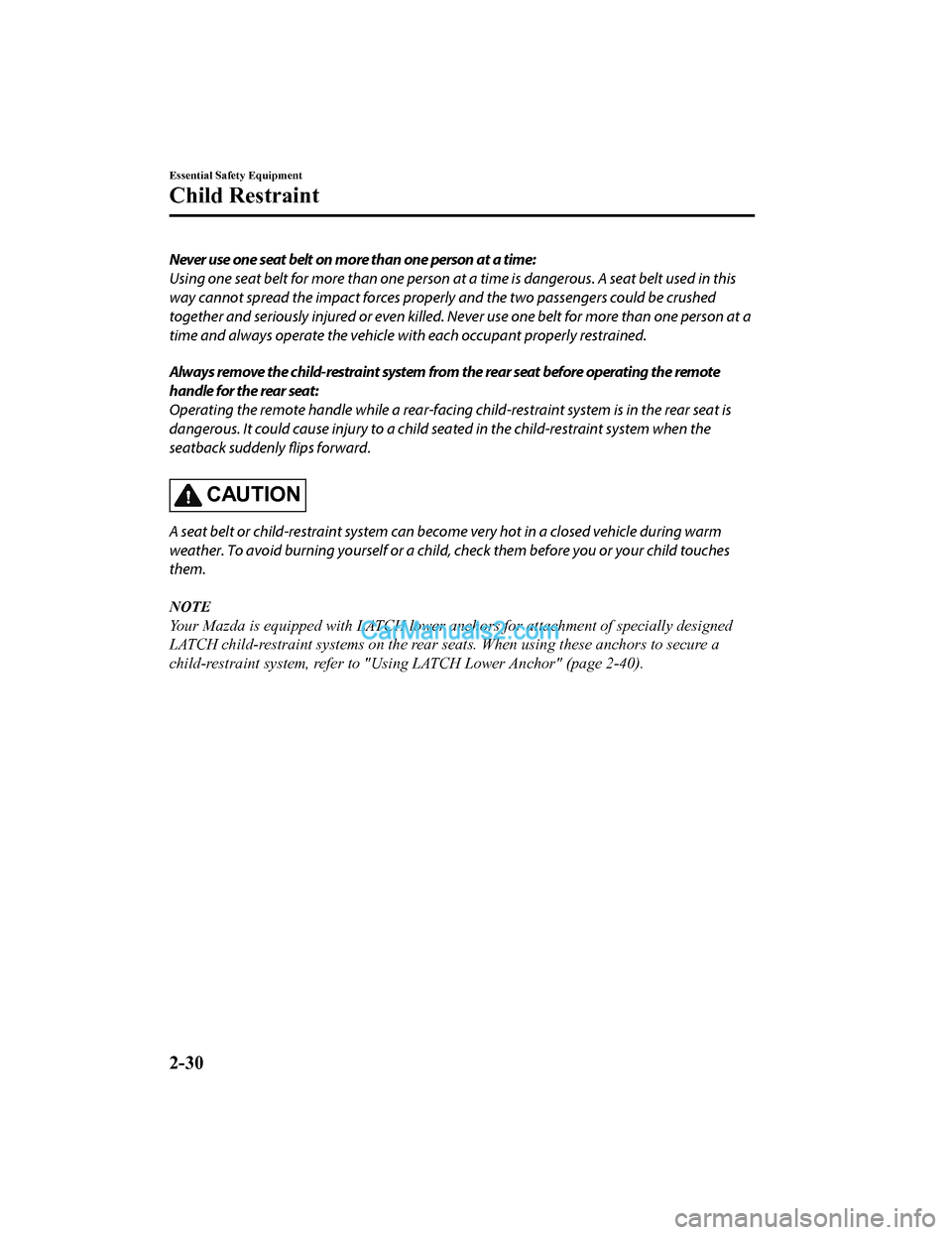
Never use one seat belt on more than one person at a time:
Using one seat belt for more than one person at a time is dangerous. A seat belt used in this
way cannot spread the impact forces properly and the two passengers could be crushed
together and seriously injured or even killed. Never use one belt for more than one person at a
time and always operate the vehicle with each occupant properly restrained.
Always remove the child-restraint system from the rear seat before operating the remote
handle for the rear seat:
Operating the remote handle while a rear-facing child-restraint system is in the rear seat is
dangerous. It could cause injury to a child seated in the child-restraint system when the
seatback suddenly flips forward.
CAUTION
A seat belt or child-restraint system can beco me very hot in a closed vehicle during warm
weather. To avoid burning yourself or a child, check them before you or your child touches
them.
NOTE
Your Mazda is equipped with LATCH lower an chors for attachment of specially designed
LATCH child-restraint systems on the rear seat s. When using these anchors to secure a
child-restraint system, refer to "U sing LATCH Lower Anchor" (page 2-40).
Essential Safety Equipment
Child Restraint
2-30
CX-5_8GN5-EA-17J_Edition1 2017-8-18 12:58:27
Page 46 of 628
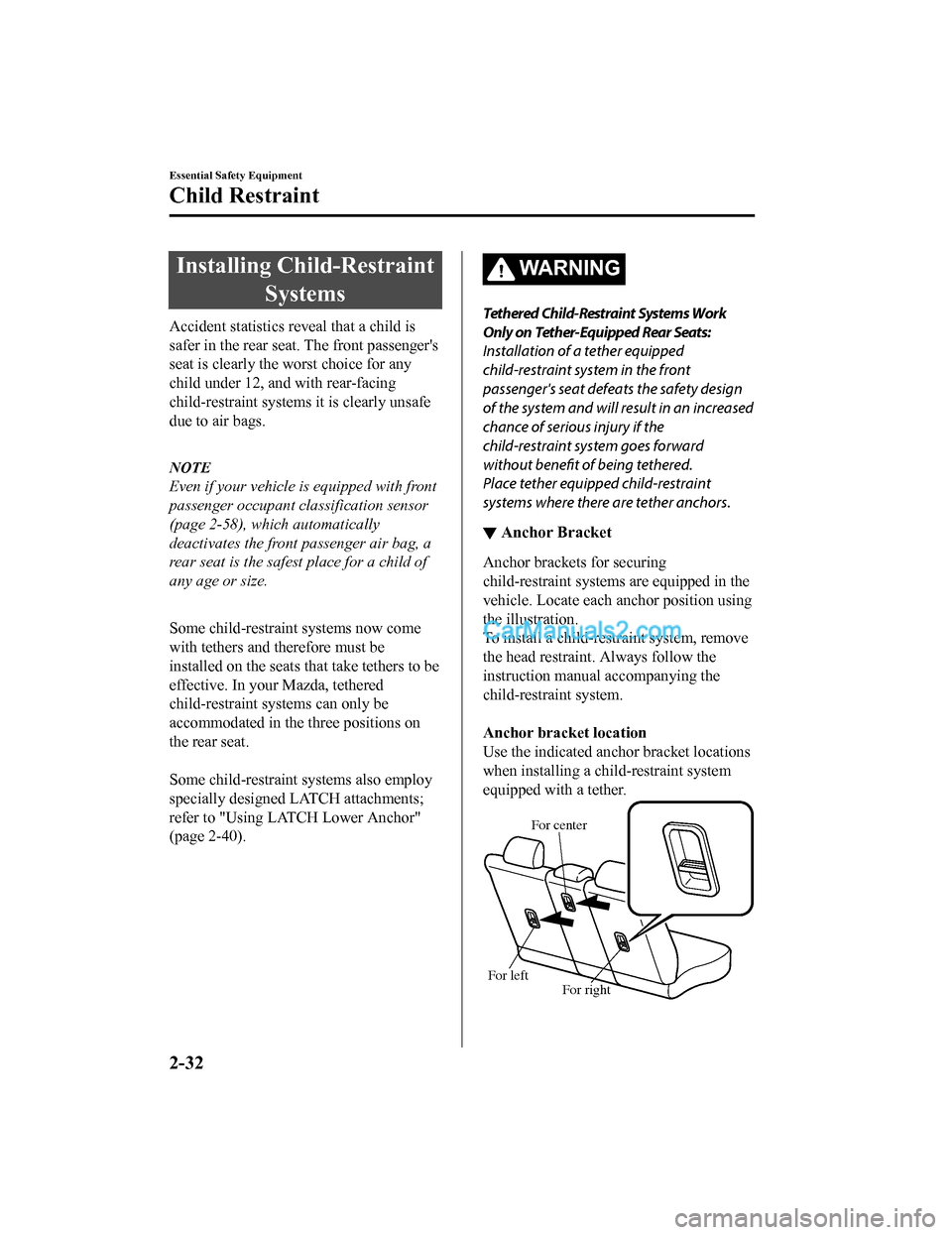
Installing Child-RestraintSystems
Accident statistics reveal that a child is
safer in the rear seat . The front passenger's
seat is clearly the worst choice for any
child under 12, and with rear-facing
child-restraint system s it is clearly unsafe
due to air bags.
NOTE
Even if your vehicle is equipped with front
passenger occupant classification sensor
(page 2-58), which automatically
deactivates the front passenger air bag, a
rear seat is the safest place for a child of
any age or size.
Some child-restraint systems now come
with tethers and t herefore must be
installed on the seats that take tethers to be
effective. In your Mazda, tethered
child-restraint systems can only be
accommodated in the three positions on
the rear seat.
Some child-restraint systems also employ
specially designed LATCH attachments;
refer to "Using LA TCH Lower Anchor"
(page 2-40).
WA R N I N G
Tethered Child-Restraint Systems Work
Only on Tether-Equipped Rear Seats:
Installation of a tether equipped
child-restraint system in the front
passenger's seat defeats the safety design
of the system and will result in an increased
chance of serious injury if the
child-restraint system goes forward
without benefit of being tethered.
Place tether equipped child-restraint
systems where there are tether anchors.
Ō¢╝ Anchor Bracket
Anchor brackets for securing
child-restraint systems are equipped in the
vehicle. Locate each anchor position using
the illustration.
To install a child-restraint system, remove
the head restraint. Always follow the
instruction manual accompanying the
child-restraint system.
Anchor bracket location
Use the indicated anchor bracket locations
when installing a ch
ild-restraint system
equipped with a tether.
For center
For left For right
Essential Safety Equipment
Child Restraint
2-32
CX-5_8GN5-EA-17J_Edition1 2017-8-18 12:58:27
Page 47 of 628
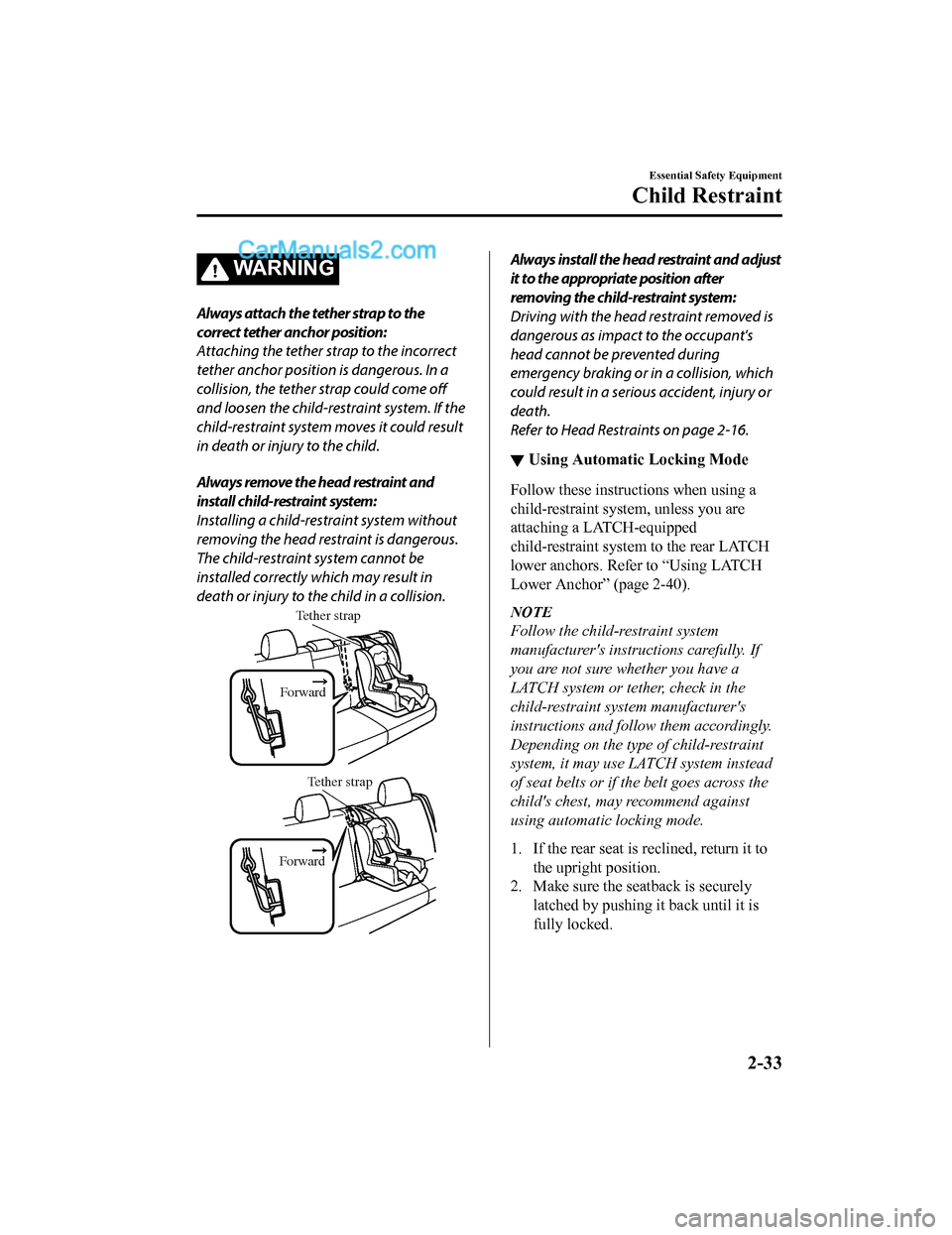
WA R N I N G
Always attach the tether strap to the
correct tether anchor position:
Attaching the tether strap to the incorrect
tether anchor position is dangerous. In a
collision, the tether strap could come off
and loosen the child-restraint system. If the
child-restraint system moves it could result
in death or injury to the child.
Always remove the head restraint and
install child-restraint system:
Installing a child-restraint system without
removing the head restraint is dangerous.
The child-restraint system cannot be
installed correctly which may result in
death or injury to the child in a collision.
Tether strap
Forward
Tether strap
Forward
Always install the head restraint and adjust
it to the appropriate position after
removing the child-restraint system:
Driving with the head restraint removed is
dangerous as impact to the occupant's
head cannot be prevented during
emergency braking or in a collision, which
could result in a serious accident, injury or
death.
Refer to Head Restraints on page 2-16.
Ō¢╝ Using Automatic Locking Mode
Follow these instructions when using a
child-restraint system, unless you are
attaching a LATCH-equipped
child-restraint syst
em to the rear LATCH
lower anchors. Refer to ŌĆ£Using LATCH
Lower AnchorŌĆØ (page 2-40).
NOTE
Follow the child-restraint system
manufacturer's instru ctions carefully. If
you are not sure whether you have a
LATCH system or tether, check in the
child-restraint system manufacturer's
instructions and follow them accordingly.
Depending on the type of child-restraint
system, it may use LATCH system instead
of seat belts or if the belt goes across the
child's chest, may recommend against
using automatic locking mode.
1. If the rear seat is reclined, return it to
the upright position.
2. Make sure the seatback is securely
latched by pushing it back until it is
fully locked.
Essential Safety Equipment
Child Restraint
2-33
CX-5_8GN5-EA-17J_Edition1 2017-8-18 12:58:27
Page 48 of 628
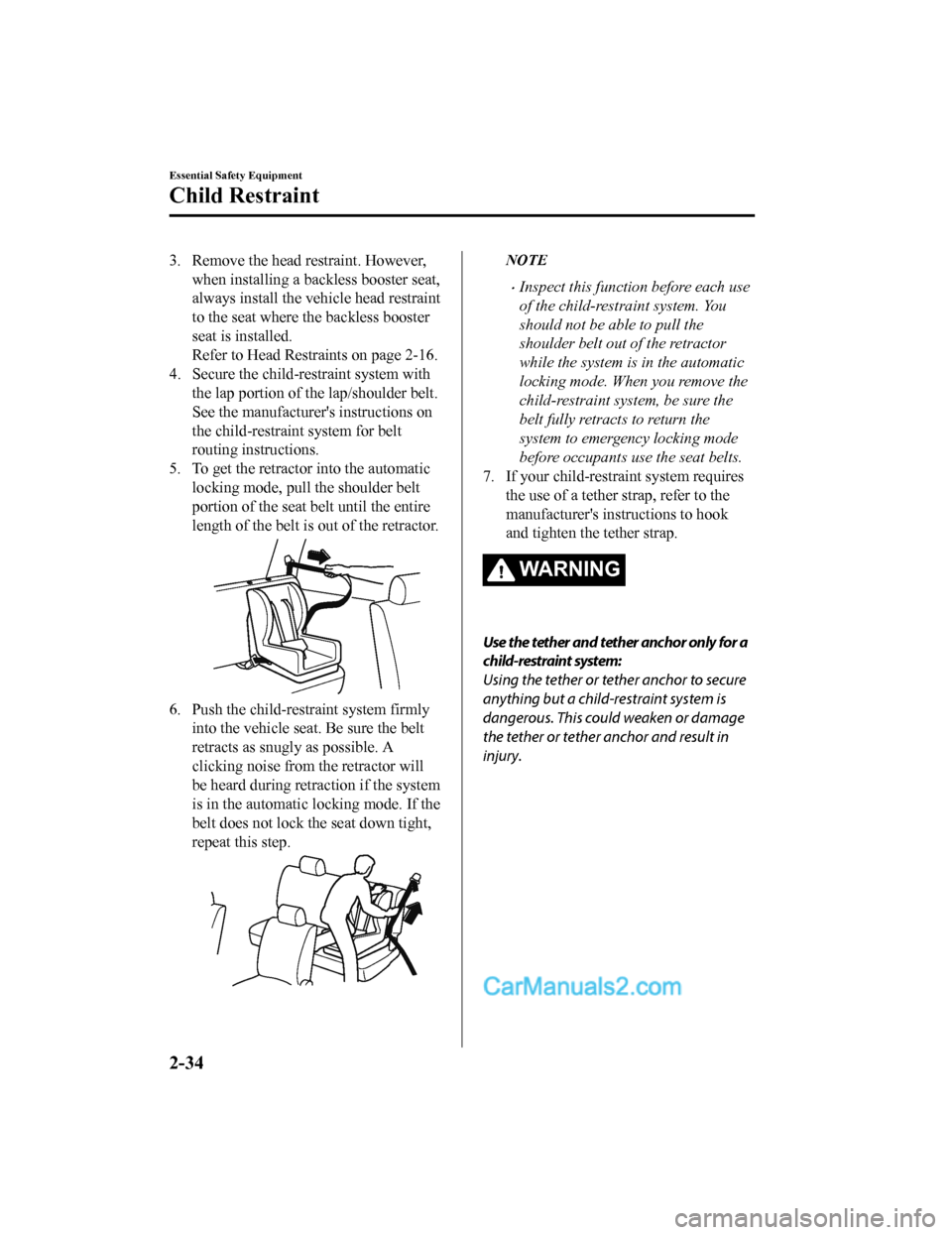
3. Remove the head restraint. However,when installing a backless booster seat,
always install the vehicle head restraint
to the seat where the backless booster
seat is installed.
Refer to Head Restra ints on page 2-16.
4. Secure the child-restraint system with the lap portion of the lap/shoulder belt.
See the manufacturer's instructions on
the child-restrain t system for belt
routing instructions.
5. To get the retractor into the automatic
locking mode, pull the shoulder belt
portion of the seat belt until the entire
length of the belt is out of the retractor.
6. Push the child-restraint system firmly into the vehicle sea t. Be sure the belt
retracts as snugly as possible. A
clicking noise from the retractor will
be heard during retraction if the system
is in the automatic locking mode. If the
belt does not lock the seat down tight,
repeat this step.
NOTE
ŌĆóInspect this function before each use
of the child-restraint system. You
should not be able to pull the
shoulder belt out of the retractor
while the system is in the automatic
locking mode. When you remove the
child-restraint system, be sure the
belt fully retracts to return the
system to emergency locking mode
before occupants use the seat belts.
7. If your child-restraint system requires the use of a tether strap, refer to the
manufacturer's instructions to hook
and tighten the tether strap.
WA R N I N G
Use the tether and tether anchor only for a
child-restraint system:
Using the tether or tether anchor to secure
anything but a child-restraint system is
dangerous. This could weaken or damage
the tether or tether anchor and result in
injury.
Essential Safety Equipment
Child Restraint
2-34
CX-5_8GN5-EA-17J_Edition1 2017-8-18 12:58:27
Page 50 of 628
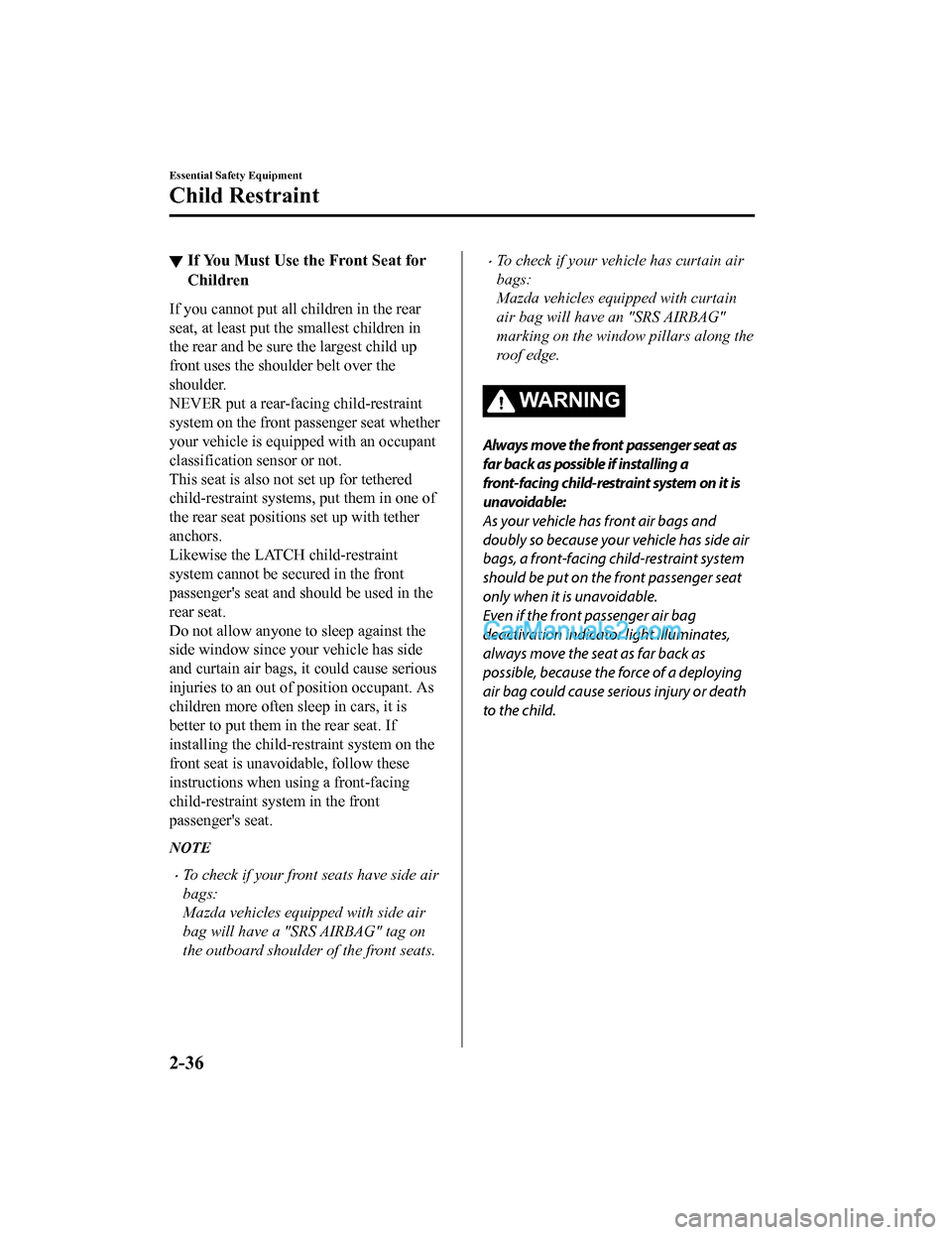
Ō¢╝If You Must Use the Front Seat for
Children
If you cannot put all children in the rear
seat, at least put the
smallest children in
the rear and be sure the largest child up
front uses the shoulder belt over the
shoulder.
NEVER put a rear-facing child-restraint
system on the front passenger seat whether
your vehicle is equipped with an occupant
classification sensor or not.
This seat is also not set up for tethered
child-restraint system s, put them in one of
the rear seat positions set up with tether
anchors.
Likewise the LATCH child-restraint
system cannot be secured in the front
passenger's seat and should be used in the
rear seat.
Do not allow anyone to sleep against the
side window since your vehicle has side
and curtain air bags, it could cause serious
injuries to an out of position occupant. As
children more often sleep in cars, it is
better to put them in the rear seat. If
installing the child-re straint system on the
front seat is unavoidable, follow these
instructions when using a front-facing
child-restraint sy stem in the front
passenger's seat.
NOTE
ŌĆóTo check if your front seats have side air
bags:
Mazda vehicles equipped with side air
bag will have a "SRS AIRBAG" tag on
the outboard shoulder of the front seats.
ŌĆóTo check if your vehicle has curtain air
bags:
Mazda vehicles equipped with curtain
air bag will have an "SRS AIRBAG"
marking on the window pillars along the
roof edge.
WA R N I N G
Always move the front passenger seat as
far back as possible if installing a
front-facing child-restraint system on it is
unavoidable:
As your vehicle has front air bags and
doubly so because your vehicle has side air
bags, a front-facing child-restraint system
should be put on the front passenger seat
only when it is unavoidable.
Even if the front passenger air bag
deactivation indicator light illuminates,
always move the seat as far back as
possible, because the force of a deploying
air bag could cause serious injury or death
to the child.
Essential Safety Equipment
Child Restraint
2-36
CX-5_8GN5-EA-17J_Edition1 2017-8-18 12:58:27
Page 52 of 628
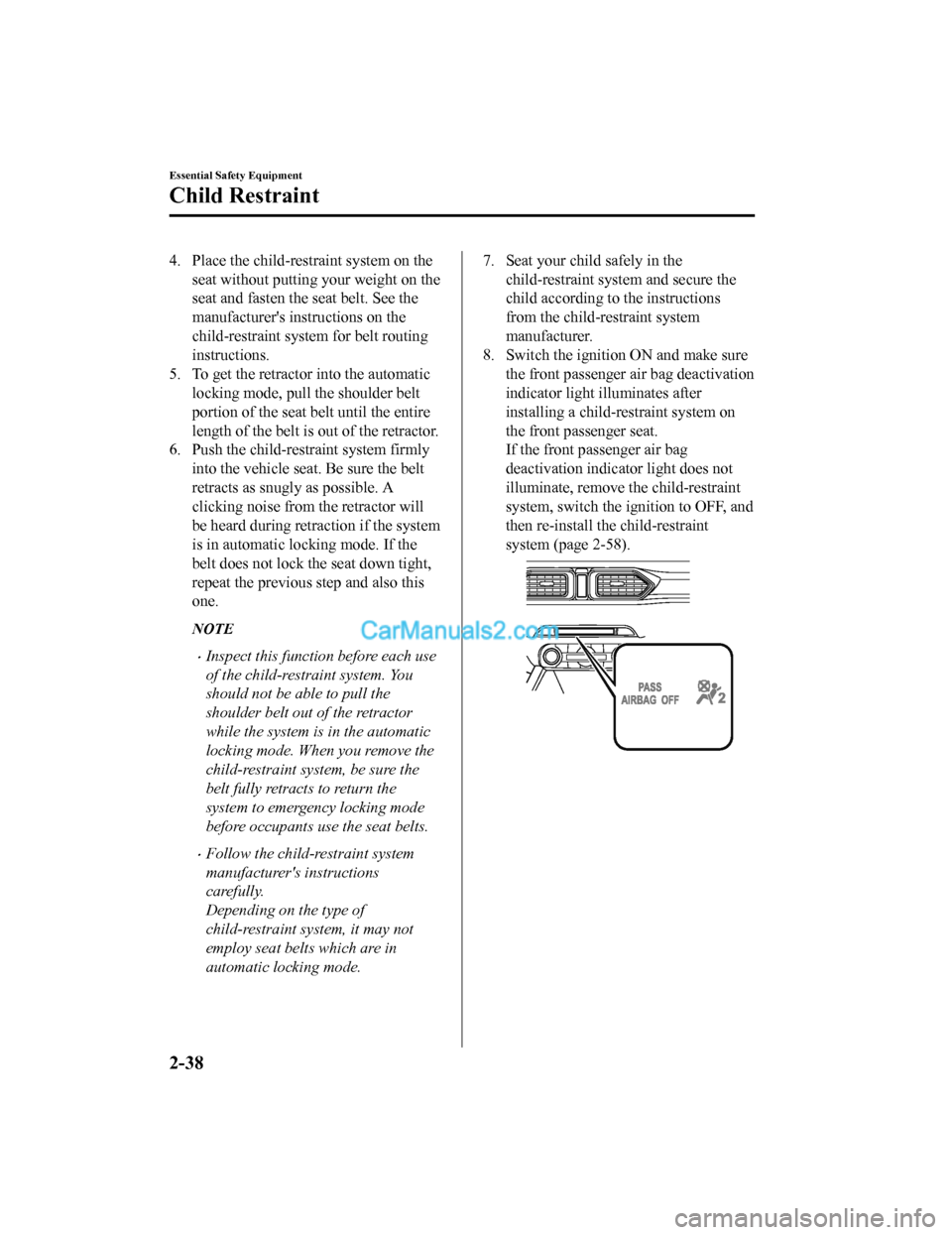
4. Place the child-restraint system on the
seat without putting your weight on the
seat and fasten the seat belt. See the
manufacturer's instructions on the
child-restraint system for belt routing
instructions.
5. To get the retractor into the automatic
locking mode, pull the shoulder belt
portion of the seat belt until the entire
length of the belt is out of the retractor.
6. Push the child-restraint system firmly
into the vehicle sea t. Be sure the belt
retracts as snugly as possible. A
clicking noise from the retractor will
be heard during retraction if the system
is in automatic lo cking mode. If the
belt does not lock the seat down tight,
repeat the previous step and also this
one.
NOTE
ŌĆóInspect this function before each use
of the child-restraint system. You
should not be able to pull the
shoulder belt out of the retractor
while the system is in the automatic
locking mode. When you remove the
child-restraint system, be sure the
belt fully retracts to return the
system to emergency locking mode
before occupants use the seat belts.
ŌĆóFollow the child-restraint system
manufacturer's instructions
carefully.
Depending on the type of
child-restraint system, it may not
employ seat belts which are in
automatic locking mode.
7. Seat your child safely in the child-restraint system and secure the
child according to the instructions
from the child-restraint system
manufacturer.
8. Switch the ignition ON and make sure the front passenger air bag deactivation
indicator light illuminates after
installing a child-restraint system on
the front passenger seat.
If the front passenger air bag
deactivation indicator light does not
illuminate, remove the child-restraint
system, switch the ignition to OFF, and
then re-install th e child-restraint
system (page 2-58).
Essential Safety Equipment
Child Restraint
2-38
CX-5_8GN5-EA-17J_Edition1 2017-8-18 12:58:27
Page 54 of 628
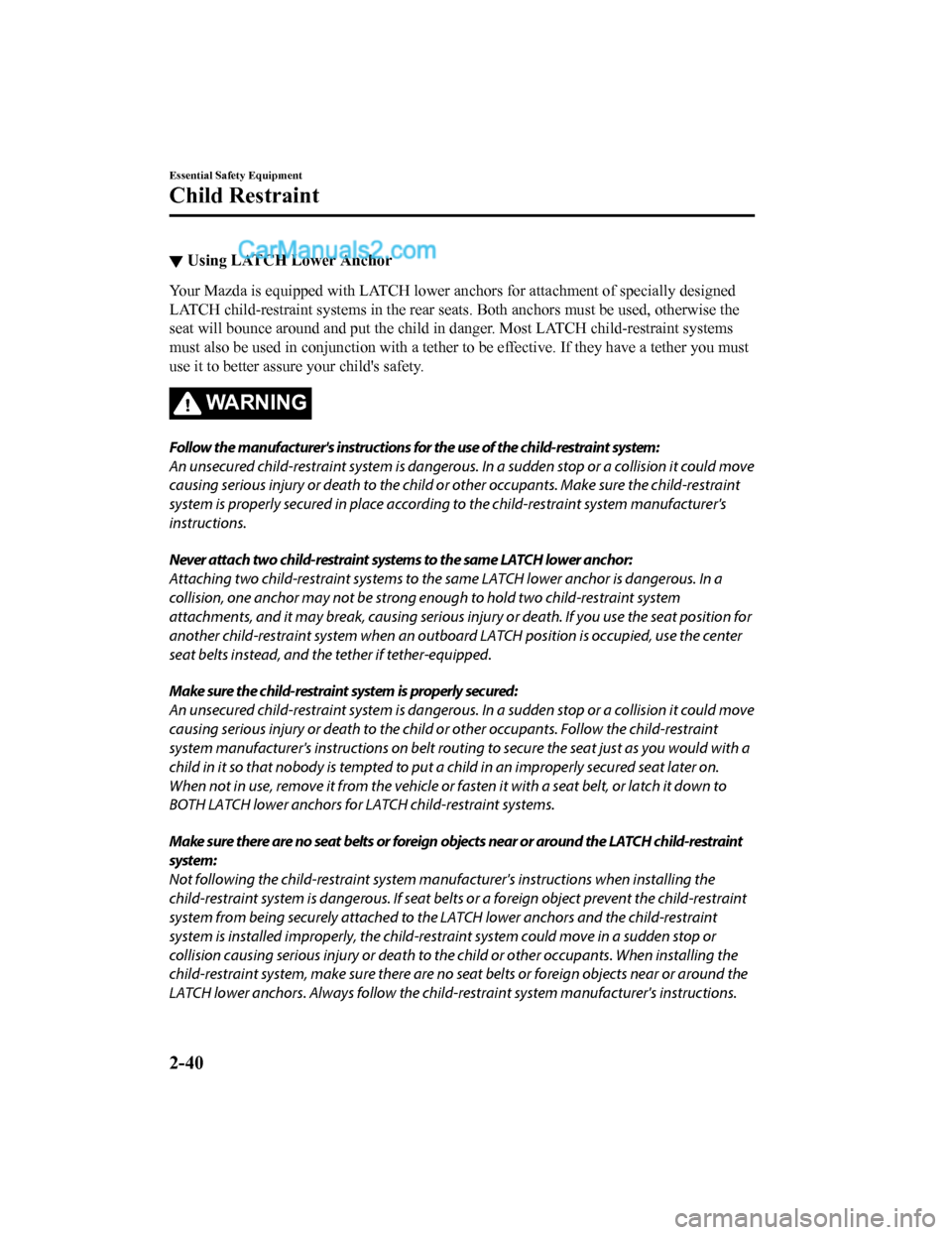
Ō¢╝Using LATCH Lower Anchor
Your Mazda is equipped with LATCH lower anchors for attachment
of specially designed
LATCH child-restraint systems in the rear seats. Both anchors m ust be used, otherwise the
seat will bounce around and put the child in danger. Most LATCH child-restraint systems
must also be used in conjunction with a tether to be effective. If they have a tether you must
use it to better assure your child's safety.
WA R N I N G
Follow the manufacturer's instructions for the use of the child-restraint system:
An unsecured child-restraint system is dangerous. In a sudden stop or a collision it could move
causing serious injury or death to the child or other occupants. Make sure the child-restraint
system is properly secured in place according to the child-restraint system manufacturer's
instructions.
Never attach two child-restraint systems to the same LATCH lower anchor:
Attaching two child-restraint systems to the same LATCH lower anchor is dangerous. In a
collision, one anchor may not be strong enough to hold two child-restraint system
attachments, and it may break, causing serious inju ry or death. If you use the seat position for
another child-restraint system when an outboard LATCH position is occupied, use the center
seat belts instead, and th e tether if tether-equipped.
Make sure the child-restraint system is properly secured:
An unsecured child-restraint system is dangerous. In a sudden stop or a collision it could move
causing serious injury or death to the child or other occupants. Follow the child-restraint
system manufacturer's instructions on belt routing to secure the seat just as you would with a
child in it so that nobody is tempted to put a child in an improperly secured seat later on.
When not in use, remove it from the vehicle or fasten it with a seat belt, or latch it down to
BOTH LATCH lower anchors for LATCH child-restraint systems.
Make sure there are no seat belts or foreign objects near or around the LATCH child-restraint
system:
Not following the child-restraint system manufacturer's instructions when installing the
child-restraint system is dangerous. If seat belt s or a foreign object prevent the child-restraint
system from being securely attached to th e LATCH lower anchors and the child-restraint
system is installed improperly, the child-restraint system could move in a sudden stop or
collision causing serious injury or death to the child or other occupants. When installing the
child-restraint system, make sure there are no seat belts or foreign objects near or around the
LATCH lower anchors. Always follow the child- restraint system manufacturer's instructions.
Essential Safety Equipment
Child Restraint
2-40
CX-5_8GN5-EA-17J_Edition1 2017-8-18 12:58:27
Page 55 of 628
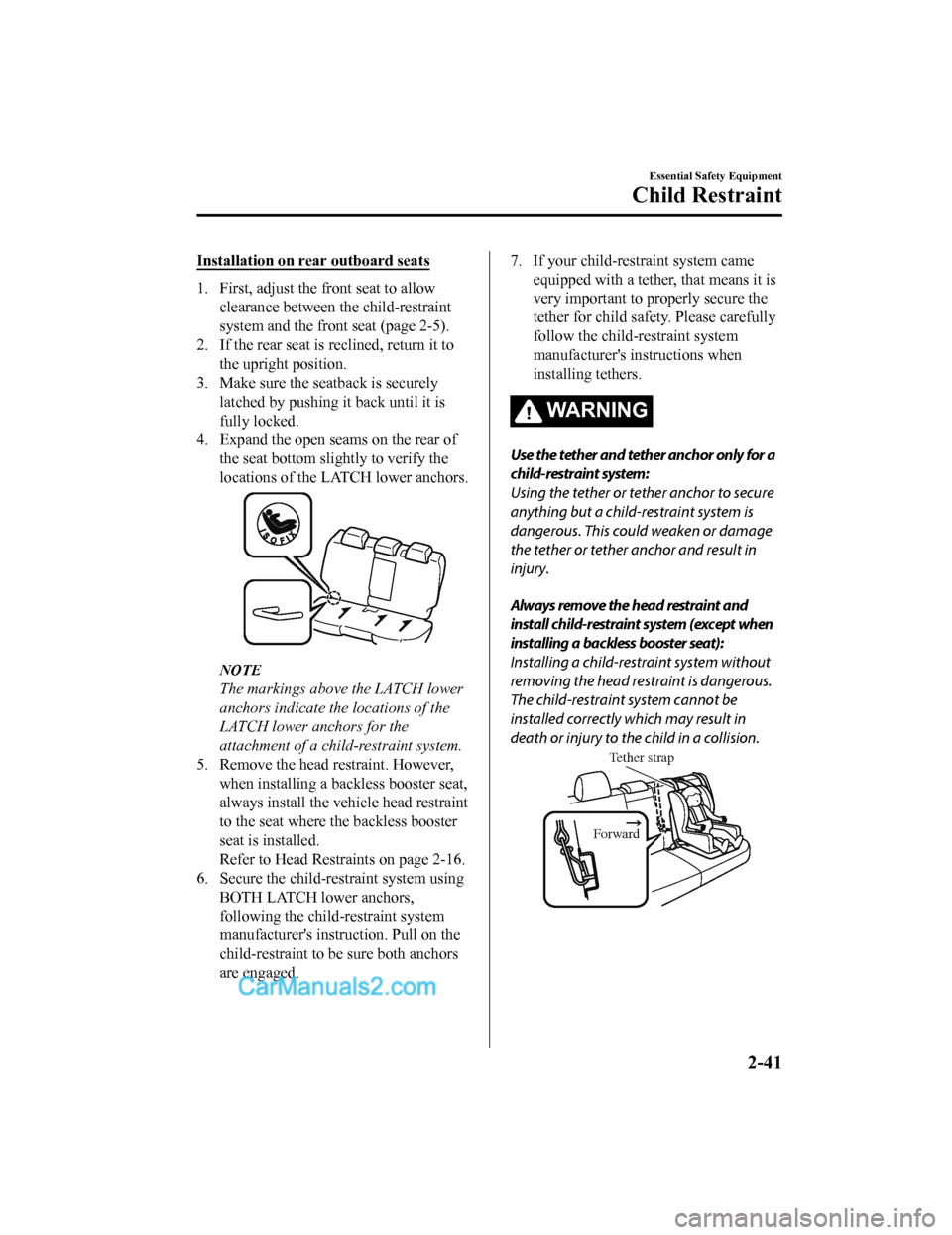
Installation on rear outboard seats
1. First, adjust the front seat to allowclearance between the child-restraint
system and the front seat (page 2-5).
2. If the rear seat is reclined, return it to
the upright position.
3. Make sure the seatback is securely latched by pushing it back until it is
fully locked.
4. Expand the open seams on the rear of the seat bottom slightly to verify the
locations of the LATCH lower anchors.
NOTE
The markings above the LATCH lower
anchors indicate the locations of the
LATCH lower anchors for the
attachment of a child-restraint system.
5. Remove the head restraint. However,
when installing a backless booster seat,
always install the vehicle head restraint
to the seat where the backless booster
seat is installed.
Refer to Head Restraints on page 2-16.
6. Secure the child-restraint system using BOTH LATCH lower anchors,
following the child-restraint system
manufacturer's instruction. Pull on the
child-restraint to be sure both anchors
are engaged.
7. If your child-restraint system cameequipped with a teth er, that means it is
very important to properly secure the
tether for child safety. Please carefully
follow the child -restraint system
manufacturer's instructions when
installing tethers.
WA R N I N G
Use the tether and tether anchor only for a
child-restraint system:
Using the tether or tether anchor to secure
anything but a child-restraint system is
dangerous. This could weaken or damage
the tether or tether anchor and result in
injury.
Always remove the head restraint and
install child-restraint system (except when
installing a backless booster seat):
Installing a child-restraint system without
removing the head restraint is dangerous.
The child-restraint system cannot be
installed correctly which may result in
death or injury to the child in a collision.
Tether strap
Forward
Essential Safety Equipment
Child Restraint
2-41
CX-5_8GN5-EA-17J_Edition1 2017-8-18 12:58:27
Page 59 of 628
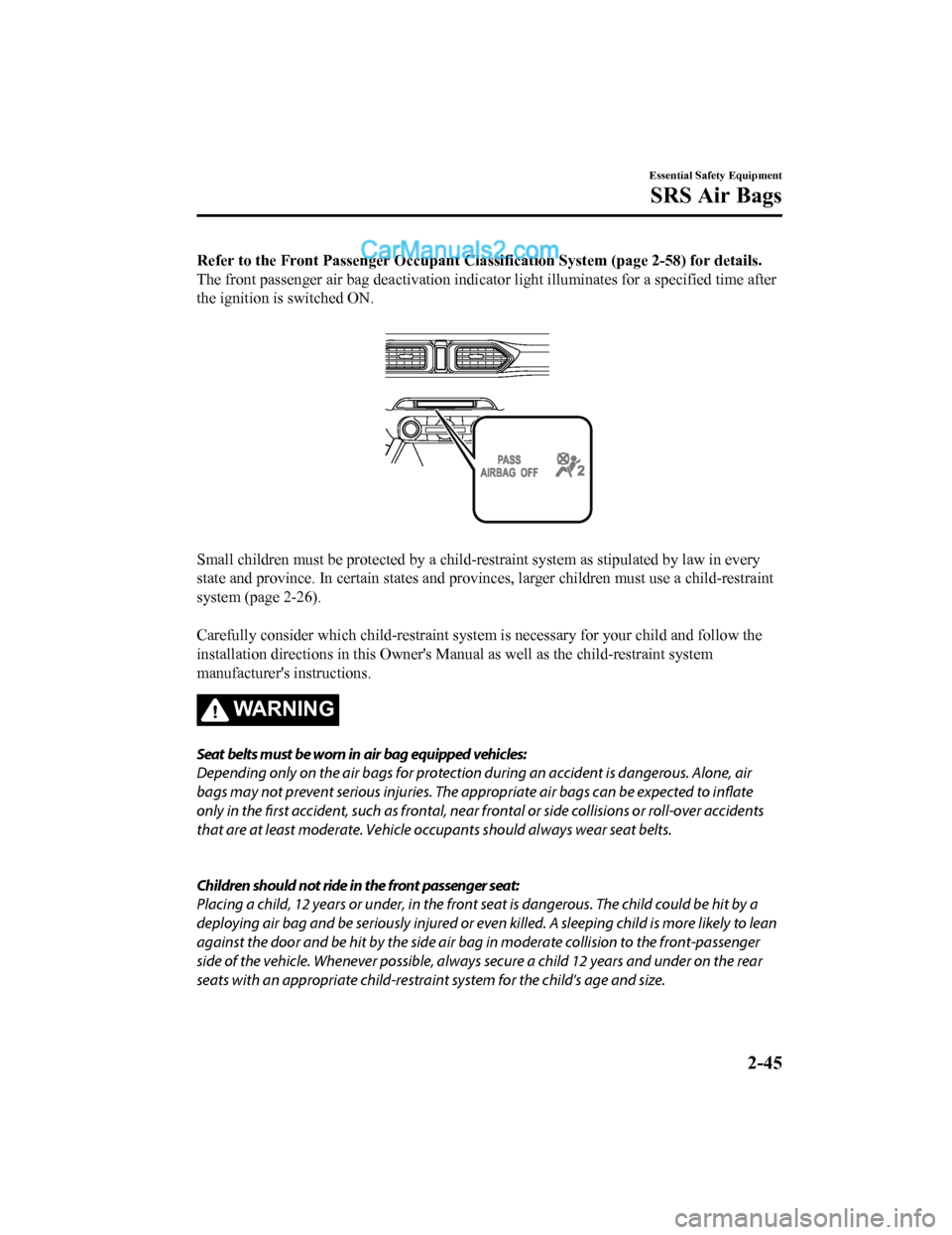
Refer to the Front Passenger Occupant Classification System (page 2-58) for details.
The front passenger air bag deactivation indicator light illuminates for a specified time after
the ignition is switched ON.
Small children mu st be protected by a child-restraint system as stipulated by law in every
state and province. In certain s tates and provinces, larger children must use a child-restraint
system (page 2-26).
Carefully consider which child-restraint system is necessary fo r your child and follow the
installation directions in this Owner's Manual as well as the c hild-restraint system
manufacturer's instructions.
WA R N I N G
Seat belts must be worn in air bag equipped vehicles:
Depending only on the air bags for protection during an accident is dangerous. Alone, air
bags may not prevent serious injuries. The appr opriate air bags can be expected to inflate
only in the first accident, such as frontal, near frontal or side collisions or roll-over accidents
that are at least moderate. Vehicle occu pants should always wear seat belts.
Children should not ride in the front passenger seat:
Placing a child, 12 years or under, in the front seat is dangerous. The child could be hit by a
deploying air bag and be seriously injured or ev en killed. A sleeping child is more likely to lean
against the door and be hit by the side air ba g in moderate collision to the front-passenger
side of the vehicle. Whenever possible, always secure a child 12 years and under on the rear
seats with an appropriate child-restraint system for the child's age and size.
Essential Safety Equipment
SRS Air Bags
2-45
CX-5_8GN5-EA-17J_Edition1 2017-8-18 12:58:27
Page 75 of 628
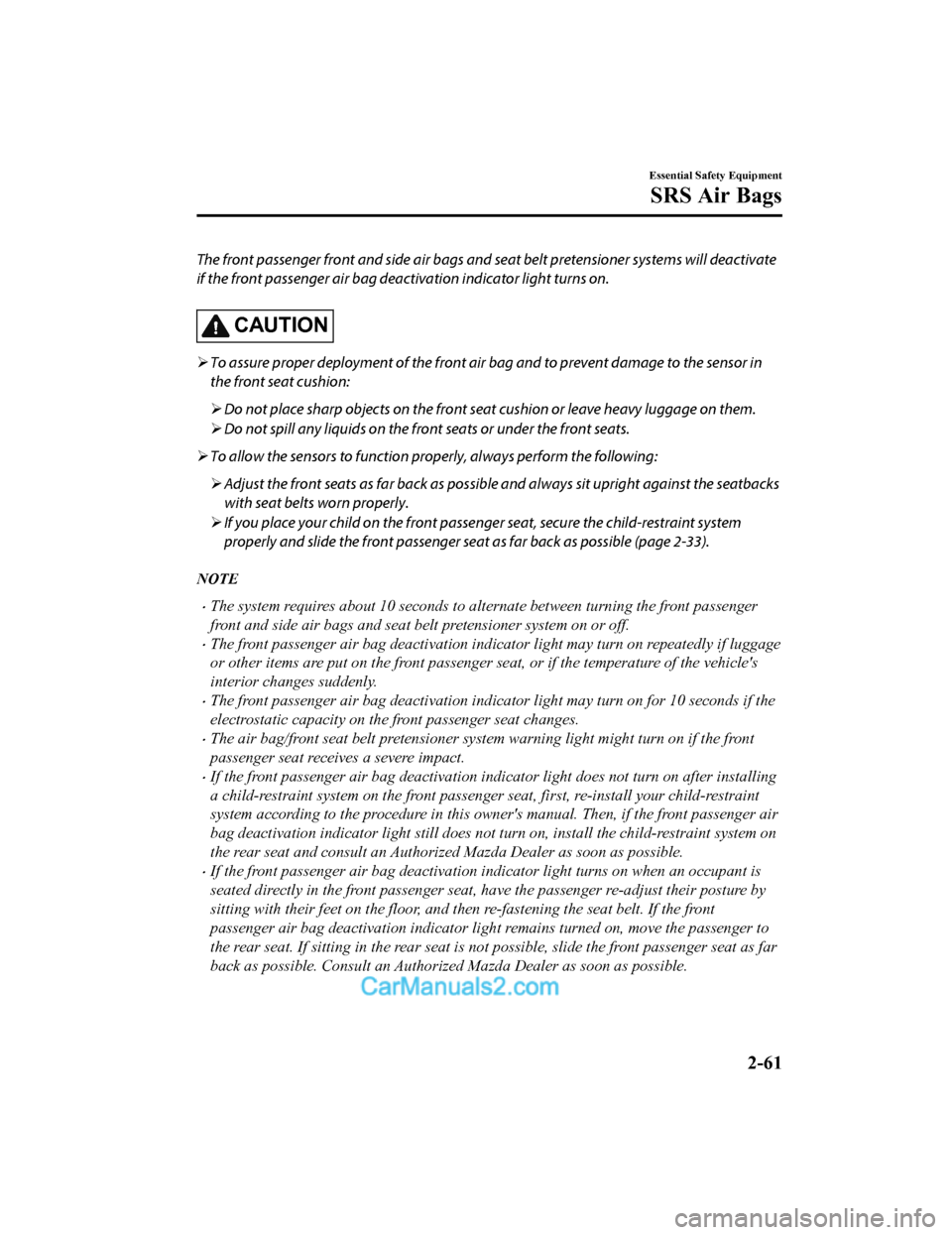
The front passenger front and side air bags and seat belt pretensioner systems will deactivate
if the front passenger air bag deactivation indicator light turns on.
CAUTION
’āś To assure proper deployment of the front air bag and to prevent damage to the sensor in
the front seat cushion:
’āś Do not place sharp objects on the front seat cushion or leave heavy luggage on them.
’āś Do not spill any liquids on the fr ont seats or under the front seats.
’āś To allow the sensors to function pr operly, always perform the following:
’āś Adjust the front seats as far back as possibl e and always sit upright against the seatbacks
with seat belts worn properly.
’āś If you place your child on the front passe nger seat, secure the child-restraint system
properly and slide the front passenger seat as far back as possible (page 2-33).
NOTE
ŌĆóThe system requires about 10 seconds to alternate between turning the front passenger
front and side air bags and seat belt pretensioner system on or off.
ŌĆóThe front passenger air bag deactivation indicator light may turn on repeatedly if luggage
or other items are put on the front passenger se at, or if the temperature of the vehicle's
interior changes suddenly.
ŌĆóThe front passenger air bag deactivation indicator light may turn on for 10 seconds if the
electrostatic capacity on the front passenger seat changes.
ŌĆóThe air bag/front seat belt pr etensioner system warning light might turn on if the front
passenger seat receives a severe impact.
ŌĆóIf the front passenger air bag deactivation indicator light does not turn on after installing
a child-restraint system on the front passenger seat, first, re-install your child-restraint
system according to the procedure in this owner's manual. Then, if the front passenger air
bag deactivation indicator light still does not turn on, install the child-restraint system on
the rear seat and consult an Authorized Mazda Dealer as soon as possible.
ŌĆóIf the front passenger air bag deactivation indicator light turns on when an occupant is
seated directly in the front passenger seat , have the passenger re-adjust their posture by
sitting with their feet on the floor, and then re-fastening the seat belt. If the front
passenger air bag deactivation indicator light remains turned on, move the passenger to
the rear seat. If sitting in the rear seat is not possible, slide the front passenger seat as far
back as possible. Consult an Authorized Mazda Dealer as soon as possible.
Essential Safety Equipment
SRS Air Bags
2-61
CX-5_8GN5-EA-17J_Edition1 2017-8-18 12:58:27